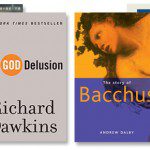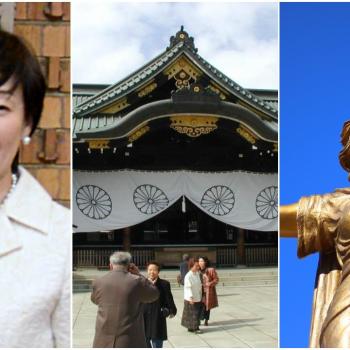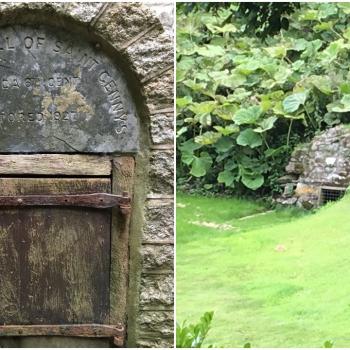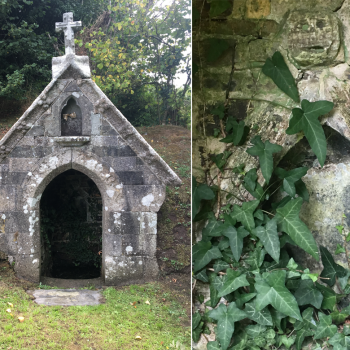Back in the days of yore when I used to teach English in Japan, I once showed my junior high school class some pictures of my family celebrating Christmas at my parents’ house. Christmas in Japan is quite a different celebration from its Western counterpart, and the children were curious to see what sorts of traditions we had. They were delighted by the photos of my family exchanging presents from under the tree, the large Nativity scene, and us all sharing a bowl of Wassail (my parents quite happily blend Christian aspects of Christmas with more Pagan elements of Yuletide).
We came to a photo of us eating Christmas dinner, and as with many English households at Christmas, we had one main meat dish and lots of vegetables. My parents aren’t fans of turkey so we never have it at Christmas. Instead, we try to come up with a different meat dish every year.
I asked my students, “Can you guess what kind of meat we’re eating?”
I had lots of answers, from the more homely chicken and beef to more imaginative answers like peacock and ostrich, but none of them got it right. Eventually I gave them a hint by singing them the first few bars of “Rudolph The Red-Nosed Reindeer.”
A gasp came from the class. “Deer?!”
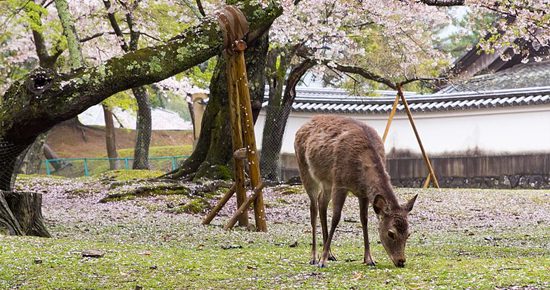
That’s right, my family had decided to eat venison that year.
I was quite surprised at the shocked response from my students. After all, Japan has plenty of deer. Surely Japan, a country renowned for cooking up all kinds of members of the animal kingdom, wouldn’t find the idea of eating deer particularly outlandish.
But no, my team-teaching Japanese teacher of English told me. Japan doesn’t really have a widespread culture of eating deer. And one of the reasons is that deer are considered sacred.
Deerly Beloved
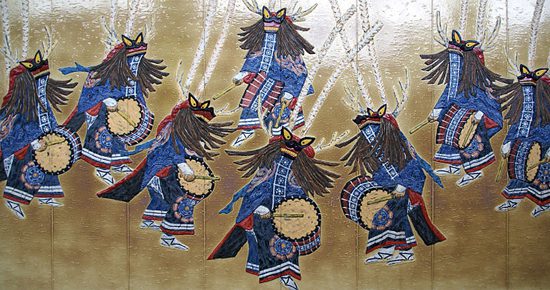
Deer are among several animals in Japan considered sacred to the kami. Like the foxes of Inari Ōkami, deer are considered to be spiritual messengers in Shinto, revered throughout Japan. In Northeastern Japan, there exists a tradition of “deer dancing” (shishi-odori), in which dancers wearing masks and antlers perform a dance in imitation of deer fighting or playing. You can find out more and watch some shishi-odori here.
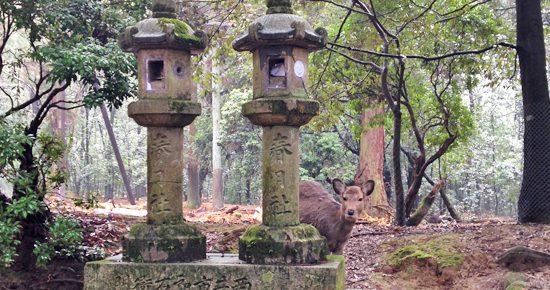
But deer are perhaps most famous in Japan as a symbol of Kasuga Grand Shrine in Nara. The city of Nara is inhabited by over 1,200 free-roaming sika deer (fun fact: the word “sika” comes from the Japanese word for deer, shika). The deer have been resident in this area since ancient times and are concentrated in the Deer Park that leads up to Kasuga Grand Shrine. The reason for the the deer’s presence in Nara is to do with the kami enshrined at Kasuga Grand Shrine, Takemikazuchi no Mikoto, the kami of thunder, swords and sumo wrestling. It is said that when Takemikazuchi was invited to Kasuga Grand Shrine from Kashima Shrine, he came astride a white deer. It’s also likely that the deer’s divine nature was reasserted by the monks of the Kofuku-ji Buddhist temple in Nara, as deer are sacred in Buddhism too; in old times, killing one was considered a crime punishable by death.
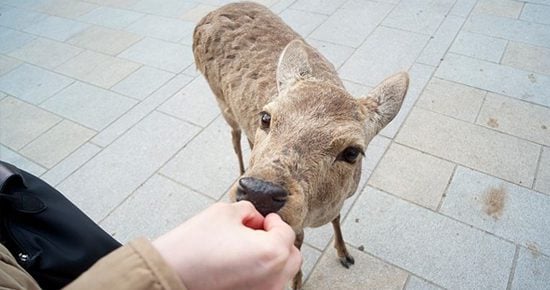
The deer in Nara are very popular with tourists, who flock to see them and feed them specially-produced rice crackers. The deer have even learned to bow their heads in order to ask for crackers! But recently, Nara has been making international news, following its decision to begin reducing the deer population.
Dealing With The Deer
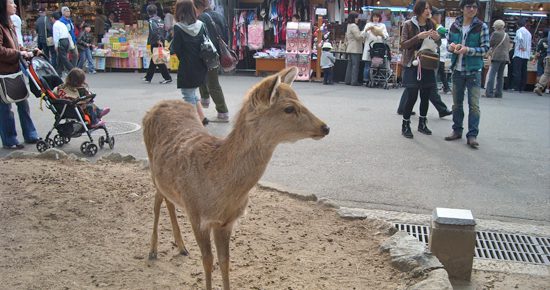
There are now just too many deer for Nara to cope with, and they’re not as benign as one might think. They damage farmers’ crops and even injure tourists – 121 people were injured by deer in the park last year, according to local government figures. So Nara have taken the step of capturing deer that stray from the border of the park.
What was particularly controversial about this move was that the original plan was to slaughter the captured deer.
However, these plans may have been halted. It appears that it didn’t take long for complaints to be registered, and for the authorities to postpone their plan of a cull, and instead adopt a strategy of re-releasing captured animals in a new location.
Clearly, the issue of killing deer remains a very sensitive one in Japan.
Deer and Neopaganism
The different attitudes toward deer in Shinto and Western Paganism is interesting. Deer are sacred animals for many Pagans too. For Pagans following a Celtic-influenced path, the deer is a symbol of the deity Cernunnos, sometimes identified with the English folkloric figure of Herne the Hunter. For Wiccans, the deer is one of the representations of the Horned God, the sacred Masculine. And for those following a Hellenic or Roman path, the deer is sacred to Artemis/Diana, Goddess of the wild and of hunting.
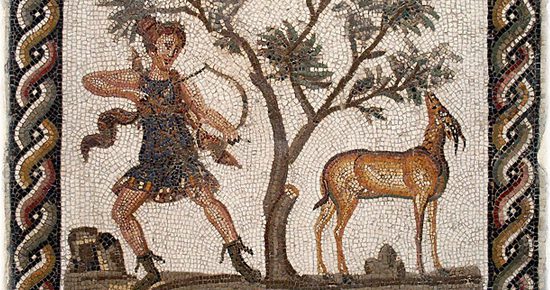
With Pagans being such a diverse bunch with no hard and fast rules, there are doubtlessly Pagans who will refrain from eating venison or using deer products. Those Pagans may refrain from doing so because they too see the deer as too sacred to kill, or simply because they are vegetarian or vegan and abstain from eating the meat or using the produce of any animal. But there are also plenty of Pagans who will happily eat venison and use deer skin and antlers. And they may do so because they see the deer as sacred.
In the examples given above, the deer is venerated specifically because it is a hunted animal. As a valuable source of protein, skin and horn, deer were the animals that gave life to people. Their veneration was a way of expressing gratitude for the abundant gifts a single deer could bestow upon a community. Pagans who consume their meat or use their products may see this as an act of respect, and a way of absorbing the energy of the animal so that they may take on some of the qualities that they associate with the deer – strength, speed, and nobility. For such Pagans, the manner in which the deer is reared, killed and eaten is important. The deer should not be subject to undue suffering at any point of the process, and the meat should be eaten with reverence, without needlessly wasting any. And if the deer that is eaten needs to be culled in order to preserve the natural environment, even better – it’s a way of making sure the deer to do not die in vain.
Venison In The Japanese Kitchen?
This makes me wonder whether eating deer, or using deerskin and antlers, could ever become mainstream in Japan. The Japanese are quite broad-minded about accepting new things into their diet, and eating venison could be a way of making sure that the deer that are culled in order to control their numbers do not die wastefully.
In fact, there are some in Japan who are considering these ideas, including C.W. Nicol, a Welsh-born Japanese citizen who writes for the Japan Times. Outside the Deer Park of Nara, deer are indeed hunted and killed. They cause significant damage to farmland and forests by eating produce and saplings, and stripping the bark from trees. As a result, the government actually encourages hunters to kill deer; according to Nicol, in 2011 123,251 deer were killed by people issued with Pest Extermination Permits, while another 183,619 were killed in the season by people with regular hunting permits. But 95% of those deer killed are simply burned or buried, and their meat and produce is not used in any way. To outsiders, it seems mottainai – a waste. Why kill an animal and not use its meat, skin or horns?
But perhaps the idea of making a meal out of Nara’s sacred deer is just a stretch too far for most Japanese. Cultural taboos surrounding food items are some of the most enduring taboos of all. It could be like expecting whale meat to go mainstream in the West…
References and further reading
- Cali, Joseph and Dougill, John. Shinto Shrines: A Guide to the Sacred Sites of Japan’s Ancient Religion
- BBC News, “Japan’s famous Nara deer face capture“
- Haikugirl’s Japan, “Shishi-Odori at the Thames Festival“
- The Japan Times, “Oh deer, what a waste of food and fashion“
- The Washington Post, “Japan’s famous Nara deer are being culled“
- Wikipedia, “Deer in mythology“, “Kasuga-taisha“, “Takemikazuchi“

